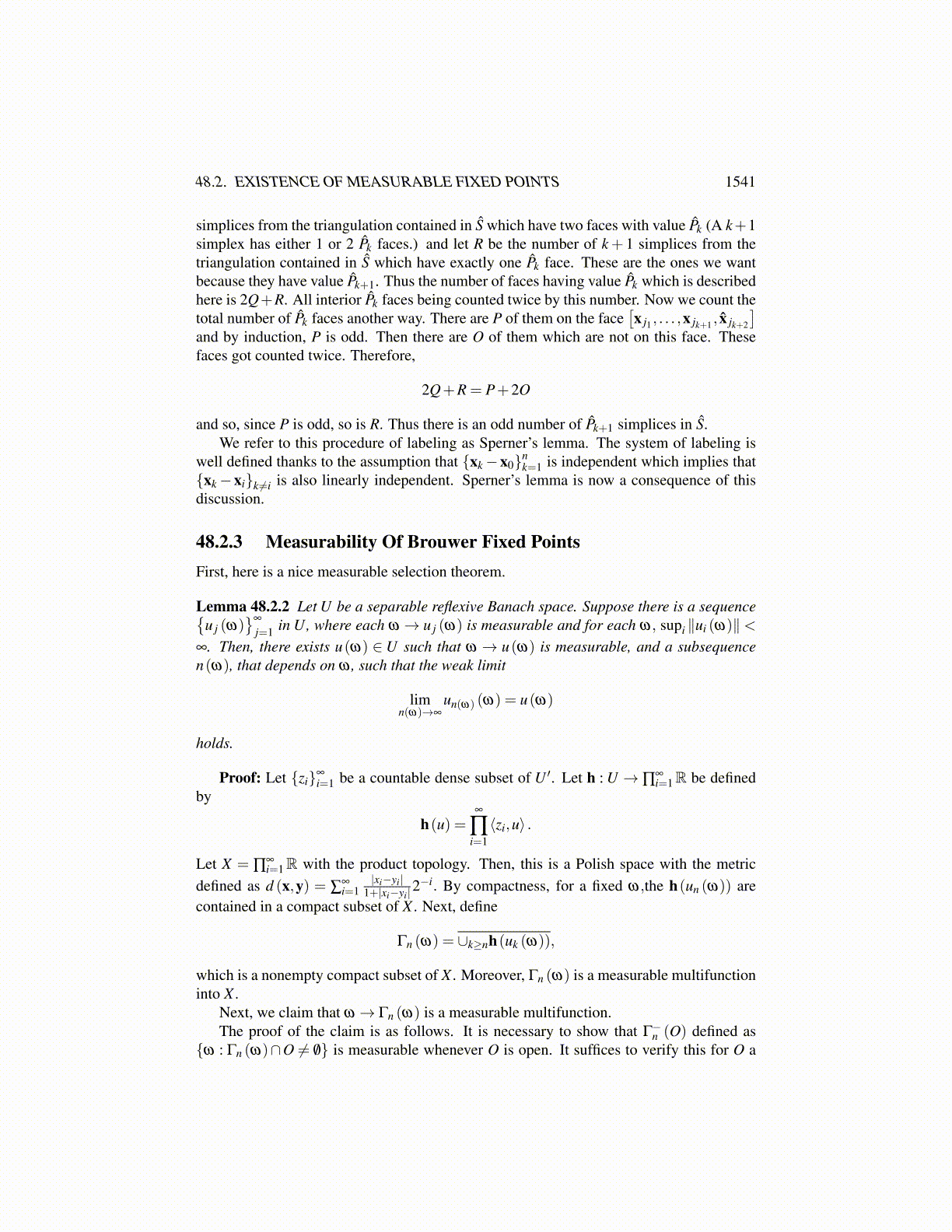
48.2. EXISTENCE OF MEASURABLE FIXED POINTS 1541
the maximum of |xk−xl | for all k ̸= l. Consider∣∣b−x j
∣∣ . It equals∣∣∑n
i=01
n+1 (xi−x j)∣∣ =∣∣∑i̸= j
1n+1 (xi−x j)
∣∣≤ nn+1 diam(S). Next consider the kth face of S [x0, · · · , x̂k, · · · ,xn]. By
induction, it has a triangulation into simplices which each have diameter no more thann
n+1 diam(S). Let these n− 1 simplices be denoted by{
Sk1, · · · ,Sk
mk
}. Then the simplices{[
Ski ,b]}mk,n+1
i=1,k=1 are a triangulation of S such that diam([
Ski ,b])≤ n
n+1 diam(S). Do for[Sk
i ,b]
what was just done for S obtaining a triangulation of S as the union of what is ob-
tained such that each simplex has diameter no more than( n
n+1
)2 diam(S). Continuing thisway shows the existence of the desired triangulation.
48.2.2 Labeling VerticesNext is a way to label the vertices. Let p0, · · · , pn be the first n+ 1 prime numbers. Allvertices of a simplex S = [x0, · · · ,xn] having {xk−x0}n
k=1 independent will be labeled withone of these primes. In particular, the vertex xk will be labeled as pk if the simplex is[x0, · · · ,xn]. The value of a simplex will be the product of its labels. Triangulate thisS. Consider a 1 simplex coming from the original simplex
[xk1 ,xk2
], label one end as
pk1 and the other as pk2 . Then label all other vertices of this triangulation which occuron[xk1 ,xk2
]either pk1 or pk2 . Then obviously there will be an odd number of simplices
in this triangulation having value pk1 pk2 , that is a pk1 at one end and a pk2 at the other.Suppose that the labeling has been done for all vertices of the triangulation which are on[x j1 , . . .x jk+1
], {
x j1 , . . .x jk+1
}⊆ {x0, . . .xn}
any k simplex for k ≤ n− 1, and there is an odd number of simplices from the triangula-tion having value equal to ∏
k+1i=1 p ji . Consider Ŝ ≡
[x j1 , . . .x jk+1 ,x jk+2
]. Then by induc-
tion, there is an odd number of k simplices on the sth face[x j1 , . . . , x̂ js , · · · ,x jk+1
]having
value ∏i ̸=s p ji . In particular the face[x j1 , . . . ,x jk+1 , x̂ jk+2
]has an odd number of simplices
with value ∏i≤k+1 p ji . Now no simplex in any other face of Ŝ can have this value byuniqueness of prime factorization. Lable the “interior” vertices, those u having all si > 0in u = ∑
k+2i=1 six ji , (These have not yet been labeled.) with any of the p j1 , · · · , p jk+2 . Pick a
simplex on the face[x j1 , . . . ,x jk+1 , x̂ jk+2
]which has value ∏i≤k+1 p ji and cross this simplex
into Ŝ. Continue crossing simplices having value ∏i≤k+1 p ji which have not been crossedtill the process ends. It must end because there are an odd number of these simplices hav-ing value ∏i≤k+1 p ji . If the process leads to the outside of Ŝ, then one can always enterit again because there are an odd number of simplices with value ∏i≤k+1 p ji available andyou will have used up an even number. When the process ends, the value of the simplexmust be ∏
k+2i=1 p ji because it will have the additional label p jk+2 on a vertex since if not,
there will be another way out of the simplex. This identifies a simplex in the triangula-tion with value ∏
k+2i=1 p ji . Then repeat the process with ∏i≤k+1 p ji valued simplices on[
x j1 , . . . ,x jk+1 , x̂ jk+2
]which have not been crossed. Repeating the process, entering from
the outside, cannot deliver a ∏k+2i=1 p ji valued simplex encountered earlier. This is because
you cross faces labeled ∏i≤k+1 p ji . If the remaining vertex is labeled p ji where i ̸= k+ 2,then this yields exactly one other face to cross. There are two, the one with the first vertexp ji and the next one with the new vertex labeled p ji substituted for the first vertex having